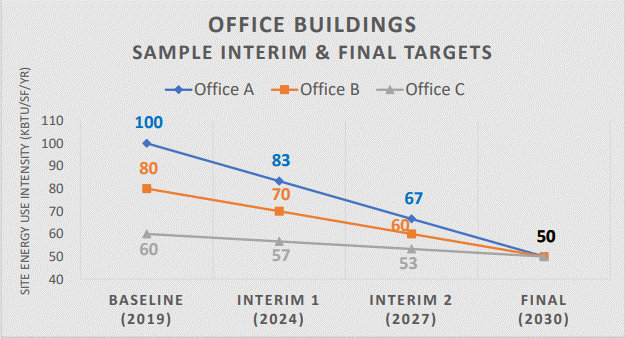On November 22, the Denver City Council, voted unanimously to pass Bill 21-1310, a building decarbonization policy that includes a building performance standard for Denver’s largest buildings. The ordinance, which is expected to be signed by Mayor Michael B. Hancock , makes the City and County of Denver the eighth U.S. jurisdiction to adopt a building performance standard and the first to employ IMT’s BPS “trajectory approach,” developed for our BPS model ordinance. Denver’s policy is notable for its comprehensive approach to building decarbonization, utilizing three separate policy mechanisms to drive energy efficiency and electrification of thermal energy loads in covered buildings:
- A building performance standard with energy efficiency requirements
- Prescriptive efficiency requirements for small commercial and multifamily buildings
- Electrification requirements for space and water heating equipment
Denver’s Building Performance Standard and the Trajectory Approach
The ordinance’s BPS requirements apply to commercial and multifamily buildings 25,000 square feet and larger and require each building to meet a maximum site energy use intensity standard based on its occupancy type by the year 2030. The ordinance gives the City and County of Denver’s Office of Climate Action, Sustainability & Resiliency (CASR) the power to set new, final EUI targets for 2040, 2050, and beyond should it be deemed necessary for the achievement of the city’s climate goals.
Buildings are also required to meet interim performance targets in 2024 and 2027 to ensure progress toward the final 2030 standard. To determine each building’s interim performance targets, Denver will draw a straight line from the building’s baseline performance in 2019 to the final standard. Thus each building’s interim standards are dependent on its “trajectory” from the baseline performance to the 2030 final standard.
The trajectory approach gives owners certainty about where their buildings’ performance ultimately needs to be while preventing them from delaying improvements unnecessarily. By giving each building a unique performance improvement trajectory, this approach recognizes that buildings start at different levels of performance and fairly and realistically distributes the level of effort required to reach the common performance goal. The diagram below depicts three hypothetical office buildings following the trajectory approach.

The ordinance directs CASR to create alternative compliance options in regulations, such as applying for adjusted timelines for meeting the EUI standards or adjustments to the building’s EUI standard due to particularities in the way the building is used or constructed to accommodate unusual situations that may hinder a building’s ability to meet the performance targets.
Additionally, the published draft rules and regulations offer a prescriptive compliance path in which buildings 25,000–100,000 square feet may comply with the 2024 and 2027 interim requirements by demonstrating that they have electrified at least 70 percent of space and water heating equipment load and that the building uses all LED lights.
Prescriptive Efficiency Requirements for Small Commercial and Multifamily Buildings
Unlike many BPS policies, the ordinance addresses energy consumption in smaller commercial and multifamily buildings (5,000–24,999 square feet), though these buildings are not expected to meet energy performance targets. Instead, Denver will require small buildings to certify that they have installed all LED lights, have installed solar panels, or purchased off-site solar that generates enough electricity to meet 20 percent of the building’s annual energy use. These requirements phase in over three years, beginning in 2025, based on building size.
Electrification Requirements
In addition to using the trajectory approach, Denver’s policy takes an innovative approach to building electrification. Denver leveraged its authority to adopt and amend its own building codes—authority many local governments in the US do not have—to require partial or full electrification of certain types of space and water heating equipment at the time of replacement. These requirements take effect in 2025 or 2027, depending on the equipment type used. Leading up to those dates, Denver will require the submittal of electrification feasibility reports for all buildings seeking permits to replace gas-fired equipment and will provide financial incentives for early adopters of heat pump technologies. After those dates, incentives will only be available to under-resourced buildings to help them achieve capital-cost parity with gas replacements.
Stakeholder Involvement
The ordinance’s adoption marks the culmination of a two-year long policy development process led by CASR. In 2020, CASR convened a Climate Action Task Force which recommended bringing Denver’s 17,000 existing commercial and multifamily buildings to net zero energy by 2040 using a building performance policy incorporating requirements for energy efficiency improvements and electrification of space and water heating. In January 2021, a second task force, the Energize Denver Task Force, was assembled to develop policy recommendations for meeting this goal, which form the basis of the ordinance.
Next Steps
CASR will now focus on finalizing the rules and regulations that will govern the policy program as well as the set-up and launch of resources to help building owners—especially those serving communities of color and low-income residents—to comply with the new requirements. The Energize Denver Task Force recommended the City provide these owners with consulting services and free energy assessments as well as incentive dollars to help subsidize project costs and mitigate potential gentrification. As Denver’s implementation plans take shape, IMT will publish future blog posts summarizing the City’s strategies for equitable policy implementation.
Implications
Denver’s policy stands out for its thoughtful approach to the related goals of energy efficiency and electrification as well as the innovative design of its BPS requirements. Coming in the wake of recent BPS policy adoptions by the State of Colorado, Boston, and Chula Vista, CA, Denver’s policy adds to the growing evidence that US state and local governments increasingly view building performance standards as a critical policy tool in their efforts to eliminate energy waste and greenhouse gas emissions from commercial and multifamily buildings.
